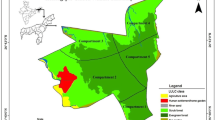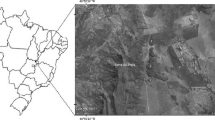Abstract
The inefficiency of conservation efforts based exclusively on natural habitat patches has called the attention of some conservationists to the matrix. Described as the major component of a landscape, the matrix is often agricultural, particularly in the tropics. In this context, agroforestry practices have been recognized for their ability to support a rich fauna and flora. Besides the extensive literature concerning bird communities in agroforestry systems, very few studies analyze how different species respond to the management of such practices. Our study describes the diet and habitat use frequency of five frugivorous bird species in agroforest home gardens, secondary forests, and pastures in the region of Pontal do Paranapanema, Brazil. The focal species were Ramphastos toco (Toco Toucan), Pteroglossus castanotis (Chestnut-eared Aracari), Amazona aestiva (Blue-fronted Amazon), Ara chloroptera (Green-winged Macaw), and Cyanocorax chrysops (Plush-crested Jay). We gathered both habitat use frequency and diet using the “feeding-bout” method. Overall frequency was higher in the secondary forest when compared to pasture and home gardens for all bird species except A. aestiva. The number of feeding bouts was higher in home gardens than in forests for all species with the exception of C. chrysops. Differences in monthly median feeding activity were only statistically significant for C. chrysops and for A. aestiva. The latter was the only species observed feeding in pasture habitats. The total number of food taxa was larger in home gardens than in the forest. Our results reinforce the importance of agroforestry systems as a resource-rich habitat for frugivorous birds.




Similar content being viewed by others
References
Calvo L, Blake M (1998) Bird diversity and abundance in two different shade-coffee plantations in Guatemala. Bird Conserv Intern 8:297–308
Carlo TA, Collazo JA, Groom MJ (2004) Influences of fruit diversity and abundance on bird use of two shaded coffee plantations. Biotropica 36:602–614
Carrara LA, Faria LP, Amaral F, Rodrigues M (2007) Dormitórios do papagaio-verdadeiro Amazona aestiva e do papagaio-galego Salvatoria xanthops em plantio comercial de eucalipto. Rev Bras Ornitol 15(1):135–138
Chazdon RL, Harvey CA, Komar O, Griffith DM, Ferguson BG, Martínez-Ramos M, Morales H et al (2009) Beyond reserves: a research agenda for conserving biodiversity in human-modified tropical landscapes. Biotropica 41(2):142–153
Cockle KL, Leonard ML, Bodrad AA (2005) Presence and abundance of birds in an Atlantic forest reserve and adjacent plantation of shade-grown yerba mate in Paraguay. Biodivers Conserv 14:3265–3288
Cullen L Jr, Beltrame TP, Lima JF, Valladares-Padua C, Padua SM (2003) Trampolins ecológicos e zonas de benefício múltiplo: ferramentas agroflorestais para a conservação de paisagens rurais fragmentadas na Floresta Atlântica Brasileira. Nat Conserv 1:37–46
Dietsch TV, Perfecto I, Greenberg R (2007) Avian foraging behavior in two different types of coffee agroecosystem in Chiapas, Mexico. Biotropica 39(2):232–240
Ditt EH (2002) Fragmentos florestais no Pontal do Paranapanema. Annablume/Ipê/IIEB, São Paulo
Faria D, Laps RR, Baumgarten J, Cetra M (2006) Bat and bird assemblages from forest and shade plantations in two contrasting landscapes in the Atlantic forest of Southern Bahia, Brazil. Biodives Conserv 15:587–612
Faria D, Paciencia ML, Dixo M, Laps RR, Baumgarten J (2007) Ferns, frogs, lizards, birds and bats in forest fragments and shade cacao plantations in two contrasting landscapes in the Atlantic forest, Brazil. Biodivers Conserv 16(8):2335–2357
Forman RT (1995) Land mosaics: the ecology of landscapes and regions. Cambridge University Press, Cambridge
Galetti M (1993) Diet of the scaly-headed parrot (Pionus maximiliani) in a semidecidual forest in Southeastern Brazil. Biotropica 25:419–425
Goulart FF (2007) Birds in agroforest home gardens of the Pontal of Paranapanema, São Paulo: epistemology, community structure and frugivory. Dissertation, Federal University of Minas Gerais
Goulart FF, Vandermeer J, Perfecto I, Matta-Machado R (2009) Análise agroecológica de dois paradigmas modernos. Rev Brasil Agroecol 4(3):76–85
Gouyon A, Foresta H, Levang P (1993) Does “jungle rubber” deserve its name? An analysis of rubber agroforestry systems in Southeast Sumatra. Agrof Syst 22:181–206
Greenberg R, Bichier P, Sterling J (1997) Bird populations in rustic and planted shade coffee plantations of eastern Chiapas, México. Biotropica 29:501–514
Jordano P (1988) Diet, fruit choice and variation in body of frugivorous warblers in Mediterranean shrub-land. Ardea 76:193–209
Komar O (2006) Ecology and conservation of birds in coffee plantations: a critical review. Bird Conserv Intern 16:1–23
Mack AL (1998) An advantage of large seed size: tolerating rather than succumbing to seed predators. Biotropica 30:604–608
Marsden SJ, Symes CT, Mack AL (2006) The response of a New Guinean avifauna to conversion of forest to small-scale agriculture. Ibis 148:629–640
Moguel P, Toledo V (1999) Biodiversity conservation in coffee systems of Mexico. Conserv Biol 13:11–21
Newmark WD (1995) Extinction of mammal populations in western North American national parks. Conserv Biol 9:512–526
Nunes F, Galetti M (2007) Use of forest fragments by blue-winged macaws (Primolius maracana) within a fragmented landscape. Biodivers Conserv 16:953–967
Perfecto I, Snelling R (1995) Biodiversity and tropical ecosystem transformation: ant diversity in the coffee agroecosystem in Costa Rica. Ecol Appl 5:1084–1097
Perfecto I, Vandermeer J (2008) Biodiversity conservation in tropical agroecosystems: a new conservation paradigm. NY Acad Sci 1134:173–200
Piñeda E, Moreno C, Escobar F, Halffter G (2005) Frog, bat and dung beetle diversity in the cloud forest and coffee agroecosystems of Vera Cruz, México. Conserv Biol 19:2058–2075
Rodello C, Cullen L, Beltrame T, Lima J, Borges H (2006) Avaliação dos programas de restauração de paisagem do Pontal do Parapanema: uma abordagem multidisciplinar. Rev Bras Agroecol 1(1):201–205
Rodrigues A, Gaston KJ (2002) Optimisation in reserve selection procedures–why not? Biol Conserv 107(1):123–129
Silva JM (1995) Birds of the Cerrado Region, South America. Streenstuspia 21:69–92
Thiollay JM (1995) The role of traditional agroforests in the conservation of rain forest bird diversity in Sumatra. Conserv Biol 9:335–353
Tscharntke T, Şekercioglu CH, Dietsch TV, Sodhi NS, Hoehn P, Tylianakis JM (2008) Landscape constraints on functional diversity of birds and insects in tropical agroecosystems. Ecology 89(4):944–951
Wunderle JM, Latta SC (2000) Winter site fidelity in neoartic migrants in shade coffee plantations of different sizes in Dominican Republic. Auk 3:596–614
Acknowledgments
This work was supported by CAPES and the University of Michigan. Thanks to Prof. Claudia Jacobi, Prof. Marcos Rodrigues, Pedro Viana, Fernando Marino, Prof. Lúcia Maria Horta de Figueiredo, Prof. Eugênio Marcos A. Goulart (Federal University of Minas Gerais), Prof. Ricardo Rudi Laps (Regional University of Blumenau), Prof. Irene Maria Cardoso (Federal University of Viçosa), Prof. Jorn Schalermann (Cambridge University), Michael Jahi Chapell (University of Michigan), Jefferson Lima (Instituto de Pesquisas Ecológicas), Prof. Miguel Â. Marini (University of Brasília), Marcelo Corrêa da Silva (University of Goiania), Prof. Maíra F. Goulart (Federal University of Jequitinhonha and Mucuri Valley) e Prof. Alexandre Uezu (Institute for Ecological Research-IPE). Thanks to all the people of Pontal, Dona Jovelina, Sr Antônio, Zezão, Mauro, Bruno, Michel, George, Dona Terezinha, Dona Cida, Renata, Sardinha (in memoriam), Marcelo, Jeison, Sr Joel, and especially José Carlos and his family, for all the support and affection. We also would like to acknowledge anonymous revisers for the meaningful comments to the draft.
Author information
Authors and Affiliations
Corresponding author
Rights and permissions
About this article
Cite this article
Goulart, F.F., Vandermeer, J., Perfecto, I. et al. Frugivory by five bird species in agroforest home gardens of Pontal do Paranapanema, Brazil. Agroforest Syst 82, 239–246 (2011). https://doi.org/10.1007/s10457-011-9398-z
Received:
Accepted:
Published:
Issue Date:
DOI: https://doi.org/10.1007/s10457-011-9398-z




